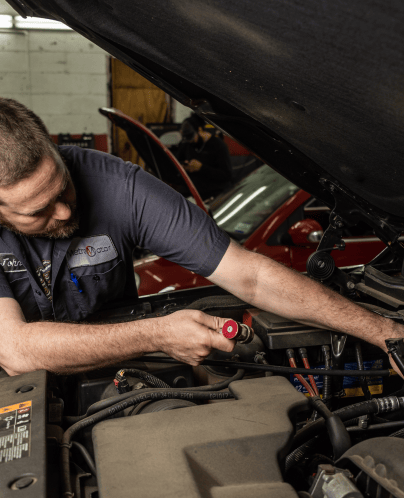All Categories
Featured

Automobile diagnostics are necessary for preserving vehicle wellness and making sure risk-free driving, and with rapid technological improvements, the way we identify cars and truck problems has actually significantly improved. Today's vehicle diagnostics rely upon innovative technologies to rapidly recognize concerns, improve repair services, and decrease downtime for both cars and motorists. Allow's discover some of the most recent innovations changing the automobile diagnostics sector.
- OBD-II and Boosted Scanners. The OBD-II (On-Board Diagnostics) system has actually been a staple in modern-day cars for decades, allowing auto mechanics to read mistake codes that can determine issues. Current improvements have actually transformed OBD-II scanners into far even more effective tools. These improved gadgets currently give extensive vehicle info, making it possible for an extra precise diagnosis of complex issues.
Secret Includes:
Advanced Code Evaluation: New OBD-II scanners can read a bigger variety of mistake codes, including those associated to advanced systems like hybrid powertrains or electric car (EV) components. Wireless Connection: Some OBD-II scanners now attach by means of Bluetooth or Wi-Fi to a smart device or tablet, giving real-time analysis information and efficiency monitoring without physical wires. 2. Expert System (AI) and Equipment Learning. Expert System (AI) and artificial intelligence are becoming game-changers in vehicle diagnostics. These innovations analyze huge amounts of data collected from lorries and use predictive models to discover issues before they create visible signs. By identifying patterns from numerous vehicle records, AI can help service technicians detect issues with an accuracy degree that had not been possible before.
Benefits:
Anticipating Upkeep: AI can anticipate when components might fail based on information patterns, allowing repair work to be made prior to break downs take place. Faster Medical diagnoses: AI systems can swiftly look via diagnostic information and recommend prospective solutions, quickening repair times. 3. Telematics and Remote Diagnostics. Telematics systems allow lorries to communicate straight with solution facilities or third-party platforms by transferring performance information in real-time. This permits vehicle repair service shops to diagnose problems from another location and recommend maintenance before the auto proprietor even notices the issue.
Benefits:
Real-Time Tracking: Service technicians can monitor a vehicle's systems continuously, permitting them to capture prospective problems as they develop. Over-the-Air (OTA) Diagnostics: Some lorries can send diagnostics wirelessly to makers, permitting for repairs or software application updates to be executed from another location, decreasing the requirement for service check outs. 4. Thermal Imaging Cameras. Thermal imaging is a cutting-edge means to spot potential troubles that are otherwise unseen to the naked eye. Making use of infrared modern technology, thermal cams highlight temperature level variations in elements, aiding service technicians area issues like overheating circuitry, liquid leaks, or engine obstruct splits.
Advantages:
Non-invasive Detection: Thermal cams allow service technicians to examine hard-to-reach locations without disassembling parts of the automobile. Quick Problem Identification: Hot areas that suggest concerns, such as overheating parts or brief circuits, can be identified practically immediately, making repairs much more efficient. 5. Endoscopes and Borescopes. Borescopes and endoscopes are small, adaptable video cameras that permit specialists to examine hard-to-reach locations in automobiles, such as inside engines, exhaust systems, or underneath the automobile's body. When identifying troubles in restricted or hidden spaces., these gadgets are important.
Secret Perks:
Access to Hidden Areas: Professionals can take a look at parts of the automobile that would normally call for disassembly, making the diagnostic process much faster and less invasive. High-Resolution Imaging: These gadgets usually feature high-definition cameras, enabling for comprehensive aesthetic examinations. 6. Augmented Fact (AR) Enhanced fact (AR) is starting to find its area on the planet of auto diagnostics, allowing specialists to superimpose vehicle data over the real-world photo of the car. AR systems can provide technicians with on-the-spot info and directions while they are servicing the automobile.
Applications:
Visual Aid: AR glasses or tablet computers show electronic overlays that reveal schematics, diagnostics, or detailed repair guides while technicians function. Efficiency: With AR, specialists can make repair services quicker due to the fact that the details they need is straight in front of them in the kind of interactive layouts and data. 7. 3D Imaging and Scanning. 3D imaging technology is significantly being utilized in the auto repair service industry to provide in-depth, three-dimensional views of lorry elements. This modern technology can aid professionals identify misalignments, damages, or wear and tear that might not be noticeable in standard 2D inspections.
Benefits:
In-depth Evaluations: With 3D scans, professionals can obtain a comprehensive understanding of a vehicle's components, specifically in complicated mechanical or structural systems. Precision: The high-resolution nature of 3D imaging allows for exceptionally precise dimensions, making certain that fixings are accurate and reliable. 8. Automobile Diagnostics via Cloud Computer. Cloud-based diagnostic tools are changing exactly how auto data is evaluated and stored. Cloud innovation permits professionals to gain access to vehicle diagnostics data from anywhere, allowing quicker decision-making and boosting cooperation between service centers and makers.
Trick Features:
Real-Time Updates: Cloud-based systems offer continuous updates on automobile performance, enabling service specialists to keep an eye on a vehicle's health remotely. Centralized Data: Data from several vehicles can be centralized on cloud systems, making it less complicated to recognize fads and offer customized solutions. Verdict. The most recent diagnostic innovations are transforming the way car repair work and upkeep are executed. From AI-powered anticipating upkeep to real-time telematics, these technologies guarantee that concerns are identified much faster and with higher precision. Whether it's with progressed OBD-II systems, remote diagnostics, or advanced devices like thermal imaging and enhanced reality, the future of car diagnostics is coming to be increasingly high-tech, making vehicle repair more reliable, precise, and much less invasive for both technicians and automobile owners alike.
Latest Posts
Improve Your Home with Overhead Door Solution
Published May 23, 25
1 min read
Understanding Roof Covering Guarantees: What Homeowners Ought To Know
Published May 22, 25
1 min read
How Consistent Auto Maintenance at Montclare Auto Repair Saves You Money
Published May 22, 25
1 min read